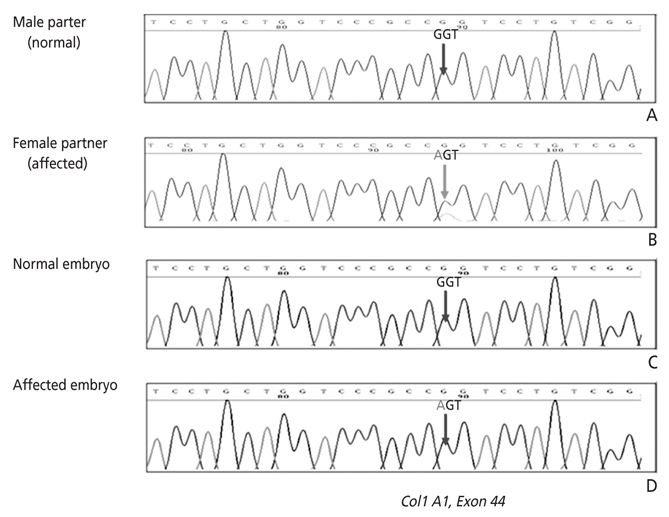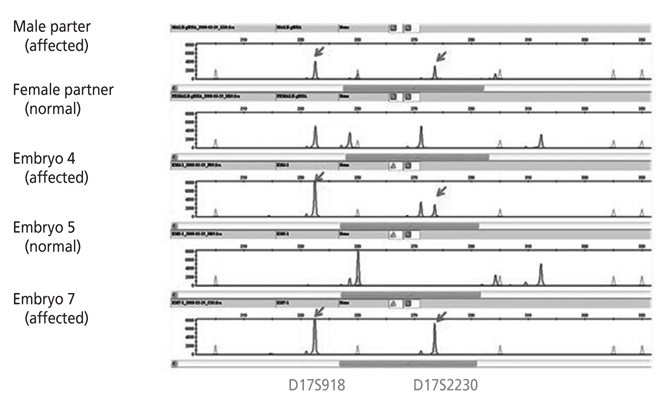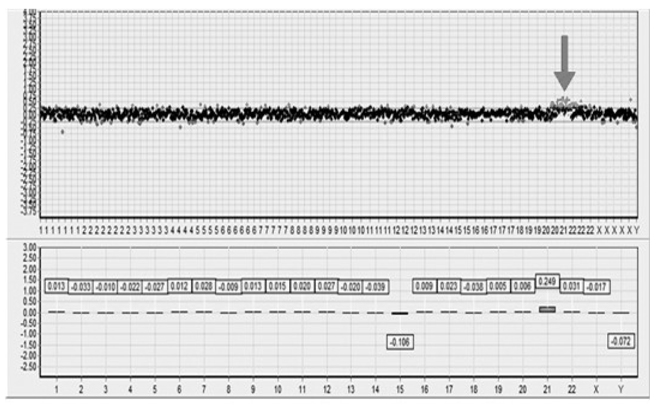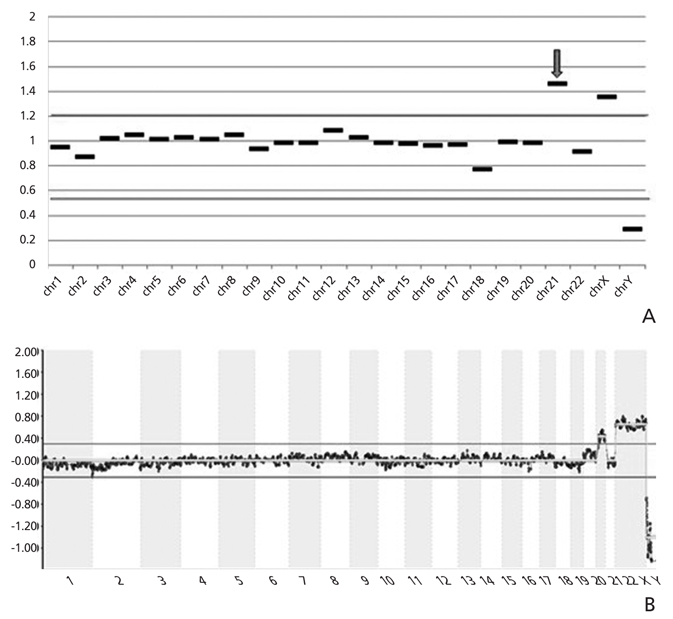J Korean Med Assoc.
2015 Nov;58(11):979-988. 10.5124/jkma.2015.58.11.979.
Preimplantation genetic diagnosis
- Affiliations
-
- 1Department of Obstetrics and Gynecology of Fertility Center, CHA University, Seoul, Korea. ikang67pgd@gmail.com
- 2Genetics Laboratory of Fertility Center, CHA Gangnam Medical Center, CHA University, Seoul, Korea.
- KMID: 2195126
- DOI: http://doi.org/10.5124/jkma.2015.58.11.979
Abstract
- Preimplantation genetic diagnosis (PGD) is a technique to examine genetic disease or chromosome abnormalities in single cell biopsied from embryos before implantation to uterus. It allows achieving normal pregnancy by transfer of unaffected embryos. The main indications are single gene disorders and recurrent miscarriage related to chromosome aberration and it has advantages to avoid termination of pregnancy or miscarriages in couples with high risk. PGD is also widely applied for aneuploidy screening in assisted reproduction to improve the outcome in infertile patients such as advanced maternal age, although its efficacy still needs to be established. Furthermore, the application of PGD has expanded to other indications, such as late onset-diseases with genetic predisposition and human leukocyte antigen typing for stem cell transplantation. With the advances of molecular diagnostic technologies using single cells, such as fluorescent in situ hybridization, multiplex polymerase chain reaction, fluorescent polymerase chain reaction, linkage analysis, whole genome amplification, array comparative genomic hybridization (array comparative genomic hybridization), and next generation sequencing, PGD can provide more comprehensive and reliable diagnosis.
Keyword
MeSH Terms
-
Abortion, Habitual
Abortion, Spontaneous
Aneuploidy
Chromosome Aberrations
Comparative Genomic Hybridization
Diagnosis
Embryonic Structures
Family Characteristics
Female
Genetic Predisposition to Disease
Genome
Humans
In Situ Hybridization, Fluorescence
Leukocytes
Mass Screening
Maternal Age
Multiplex Polymerase Chain Reaction
Pathology, Molecular
Polymerase Chain Reaction
Pregnancy
Preimplantation Diagnosis*
Prostaglandins D
Reproduction
Stem Cell Transplantation
Uterus
Prostaglandins D
Figure
Cited by 1 articles
-
Shift of paradigm in prenatal diagnosis
Do Yeong Hwang
J Korean Med Assoc. 2015;58(11):976-978. doi: 10.5124/jkma.2015.58.11.976.
Reference
-
1. Hardy K, Martin KL, Leese HJ, Winston RM, Handyside AH. Human preimplantation development in vitro is not adversely affected by biopsy at the 8-cell stage. Hum Reprod. 1990; 5:708–714.
Article2. Handyside AH, Kontogianni EH, Hardy K, Winston RM. Pregnancies from biopsied human preimplantation embryos sexed by Y-specific DNA amplification. Nature. 1990; 344:768–770.
Article3. Staessen C, Van Assche E, Joris H, Bonduelle M, Vandervorst M, Liebaers I, Van Steirteghem A. Clinical experience of sex determination by fluorescent in-situ hybridization for preimplantation genetic diagnosis. Mol Hum Reprod. 1999; 5:382–389.
Article4. Goossens V, Traeger-Synodinos J, Coonen E, De Rycke M, Moutou C, Pehlivan T, Derks-Smeets IA, Harton G. ESHRE PGD Consortium data collection XI: cycles from January to December 2008 with pregnancy follow-up to October 2009. Hum Reprod. 2012; 27:1887–1911.
Article5. de Boer KA, Catt JW, Jansen RP, Leigh D, McArthur S. Moving to blastocyst biopsy for preimplantation genetic diagnosis and single embryo transfer at Sydney IVF. Fertil Steril. 2004; 82:295–298.
Article6. Gardner DK, Vella P, Lane M, Wagley L, Schlenker T, Schoolcraft WB. Culture and transfer of human blastocysts increases implantation rates and reduces the need for multiple embryo transfers. Fertil Steril. 1998; 69:84–88.
Article7. McArthur SJ, Leigh D, Marshall JT, de Boer KA, Jansen RP. Pregnancies and live births after trophectoderm biopsy and preimplantation genetic testing of human blastocysts. Fertil Steril. 2005; 84:1628–1636.
Article8. Schoolcraft WB, Treff NR, Stevens JM, Ferry K, Katz-Jaffe M, Scott RT Jr. Live birth outcome with trophectoderm biopsy, blastocyst vitrification, and single-nucleotide polymorphism microarray-based comprehensive chromosome screening in infertile patients. Fertil Steril. 2011; 96:638–640.
Article9. Verlinsky Y, Cieslak J, Ivakhnenko V, Lifchez A, Strom C, Kuliev A. Birth of healthy children after preimplantation diagnosis of common aneuploidies by polar body fluorescent in situ hybridization analysis: Preimplantation Genetics Group. Fertil Steril. 1996; 66:126–129.
Article10. Munne S, Sandalinas M, Escudero T, Fung J, Gianaroli L, Co-hen J. Outcome of preimplantation genetic diagnosis of translocations. Fertil Steril. 2000; 73:1209–1218.
Article11. Munne S, Sandalinas M, Escudero T, Marquez C, Cohen J. Chromosome mosaicism in cleavage-stage human embryos: evidence of a maternal age effect. Reprod Biomed Online. 2002; 4:223–232.
Article12. Fiorentino F, Biricik A, Nuccitelli A, De Palma R, Kahraman S, Iacobelli M, Trengia V, Caserta D, Bonu MA, Borini A, Baldi M. Strategies and clinical outcome of 250 cycles of preimplantation genetic diagnosis for single gene disorders. Hum Reprod. 2006; 21:670–684.
Article13. Kim MJ, Lee HS, Choi HW, Lim CK, Cho JW, Kim JY, Song IO, Kang IS. Establishment and application of molecular genetic techniques for preimplantation genetic diagnosis of osteogenesis imperfecta. Korean J Reprod Med. 2008; 35:99–110.14. Holding C, Monk M. Diagnosis of beta-thalassaemia by DNA amplification in single blastomeres from mouse preimplantation embryos. Lancet. 1989; 2:532–535.
Article15. Lee HS, Choi HW, Lim CK, Min DM, Byun HK, Kim JY, Koong MK, Yoo HW, Kim SC, Jun JH, Kang IS. Successful preimplantation genetic diagnosis for ornithine transcarbamylase deficiency, junctional epidermolysis bullosa and lactic acidosis using duplex nested PCR: delivery of healthy baby by specific preimplantation genetic diagnosis for ornithine tran. Korean J Obstet Gynecol. 2004; 47:708–718.16. Dreesen JC, Jacobs LJ, Bras M, Herbergs J, Dumoulin JC, Geraedts JP, Evers JL, Smeets HJ. Multiplex PCR of polymorphic markers flanking the CFTR gene: a general approach for preimplantation genetic diagnosis of cystic fibrosis. Mol Hum Reprod. 2000; 6:391–396.
Article17. Lee HS, Kim MJ, Ko DS, Jeon EJ, Kim JY, Kang IS. Preimplantation genetic diagnosis for Charcot-Marie-Tooth disease. Clin Exp Reprod Med. 2013; 40:163–168.
Article18. Zhang L, Cui X, Schmitt K, Hubert R, Navidi W, Arnheim N. Whole genome amplification from a single cell: implications for genetic analysis. Proc Natl Acad Sci U S A. 1992; 89:5847–5851.
Article19. Telenius H, Carter NP, Bebb CE, Nordenskjold M, Ponder BA, Tunnacliffe A. Degenerate oligonucleotide-primed PCR: general amplification of target DNA by a single degenerate primer. Genomics. 1992; 13:718–725.
Article20. Handyside AH, Robinson MD, Simpson RJ, Omar MB, Shaw MA, Grudzinskas JG, Rutherford A. Isothermal whole genome amplification from single and small numbers of cells: a new era for preimplantation genetic diagnosis of inherited disease. Mol Hum Reprod. 2004; 10:767–772.
Article21. Burlet P, Frydman N, Gigarel N, Kerbrat V, Tachdjian G, Feyereisen E, Bonnefont JP, Frydman R, Munnich A, Steffann J. Multiple displacement amplification improves PGD for fragile X syndrome. Mol Hum Reprod. 2006; 12:647–652.
Article22. Langmore JP. Rubicon Genomics, Inc. Pharmacogenomics. 2002; 3:557–560.
Article23. Barker DL, Hansen MS, Faruqi AF, Giannola D, Irsula OR, Lasken RS, Latterich M, Makarov V, Oliphant A, Pinter JH, Shen R, Sleptsova I, Ziehler W, Lai E. Two methods of wholegenome amplification enable accurate genotyping across a 2320-SNP linkage panel. Genome Res. 2004; 14:901–907.
Article24. Treff NR, Su J, Kasabwala N, Tao X, Miller KA, Scott RT Jr. Robust embryo identification using first polar body single nucleotide polymorphism microarray-based DNA fingerprinting. Fertil Steril. 2010; 93:2453–2455.
Article25. Hegde MR, Chin EL, Mulle JG, Okou DT, Warren ST, Zwick ME. Microarray-based mutation detection in the dystrophin gene. Hum Mutat. 2008; 29:1091–1099.26. Colls P, Escudero T, Fischer J, Cekleniak NA, Ben-Ozer S, Meyer B, Damien M, Grifo JA, Hershlag A, Munne S. Validation of array comparative genome hybridization for diagnosis of translocations in preimplantation human embryos. Reprod Biomed Online. 2012; 24:621–629.
Article27. Munne S. Preimplantation genetic diagnosis for aneuploidy and translocations using array comparative genomic hybridization. Curr Genomics. 2012; 13:463–470.
Article28. Wells D, Kaur K, Grifo J, Glassner M, Taylor JC, Fragouli E, Munne S. Clinical utilisation of a rapid low-pass whole genome sequencing technique for the diagnosis of aneuploidy in human embryos prior to implantation. J Med Genet. 2014; 51:553–562.
Article29. Lukaszuk K, Pukszta S, Wells D, Cybulska C, Liss J, Plociennik L, Kuczynski W, Zabielska J. Routine use of next-generation se-quencing for preimplantation genetic diagnosis of blastomeres obtained from embryos on day 3 in fresh in vitro fertilization cycles. Fertil Steril. 2015; 103:1031–1036.30. Fiorentino F, Bono S, Biricik A, Nuccitelli A, Cotroneo E, Cottone G, Kokocinski F, Michel CE, Minasi MG, Greco E. Application of next-generation sequencing technology for comprehensive aneuploidy screening of blastocysts in clinical preimplantation genetic screening cycles. Hum Reprod. 2014; 29:2802–2813.
Article31. Handyside AH, Lesko JG, Tarin JJ, Winston RM, Hughes MR. Birth of a normal girl after in vitro fertilization and preimplan-tation diagnostic testing for cystic fibrosis. N Engl J Med. 1992; 327:905–909.
Article32. Harper JC, Boelaert K, Geraedts J, Harton G, Kearns WG, Moutou C, Muntjewerff N, Repping S, SenGupta S, Scriven PN, Traeger-Synodinos J, Vesela K, Wilton L, Sermon KD. ESHRE PGD Consortium data collection V: cycles from January to De-cember 2002 with pregnancy follow-up to October 2003. Hum Reprod. 2006; 21:3–21.
Article33. Lim CK, Jun JH, Min DM, Lee HS, Kim JY, Koong MK, Kang IS. Efficacy and clinical outcome of preimplantation genetic diagnosis using FISH for couples of reciprocal and Robertsonian translocations: the Korean experience. Prenat Diagn. 2004; 24:556–561.
Article34. Kim JY, Lim CK, Song IO, Yoo KJ, Yang KM, Han KS, Hur K, Song JH, Jun JH, Min DM, Park SY, Jun JY, Koong MK, Kang IS. Outcome of preimplantation genetic diagnosis for chromosome aneuploidy and genetic disease. Korean J Fertil Steril. 2002; 29:269–278.35. Munne S, Cohen J, Sable D. Preimplantation genetic diagnosis for advanced maternal age and other indications. Fertil Steril. 2002; 78:234–236.
Article36. Mastenbroek S, Twisk M, van Echten-Arends J, Sikkema-Raddatz B, Korevaar JC, Verhoeve HR, Vogel NE, Arts EG, de Vries JW, Bossuyt PM, Buys CH, Heineman MJ, Repping S, van der Veen F. In vitro fertilization with preimplantation genetic screening. N Engl J Med. 2007; 357:9–17.
Article37. Scott RT Jr, Upham KM, Forman EJ, Hong KH, Scott KL, Taylor D, Tao X, Treff NR. Blastocyst biopsy with comprehensive chromosome screening and fresh embryo transfer significantly increases in vitro fertilization implantation and delivery rates: a randomized controlled trial. Fertil Steril. 2013; 100:697–703.
Article38. Rechitsky S, Verlinsky O, Chistokhina A, Sharapova T, Ozen S, Masciangelo C, Kuliev A, Verlinsky Y. Preimplantation genetic diagnosis for cancer predisposition. Reprod Biomed Online. 2002; 5:148–155.
Article39. Kahraman S, Beyazyurek C, Ekmekci CG. Seven years of experience of preimplantation HLA typing: a clinical overview of 327 cycles. Reprod Biomed Online. 2011; 23:363–371.
Article
- Full Text Links
- Actions
-
Cited
- CITED
-
- Close
- Share
- Similar articles
-
- Clinical Application of Preimplantation Genetic Diagnosis (PGD)
- Recent Trends in Preimplantation Genetic Diagnosis (PGD)
- Preimplantation Genetic Diagnosis
- A Case of Successful Pregnancy in Patient with Recurrent Spontaneous Abortion by Preimplantation Genetic Diagnosis Following IVF-ET
- Genomic aspects in reproductive medicine






